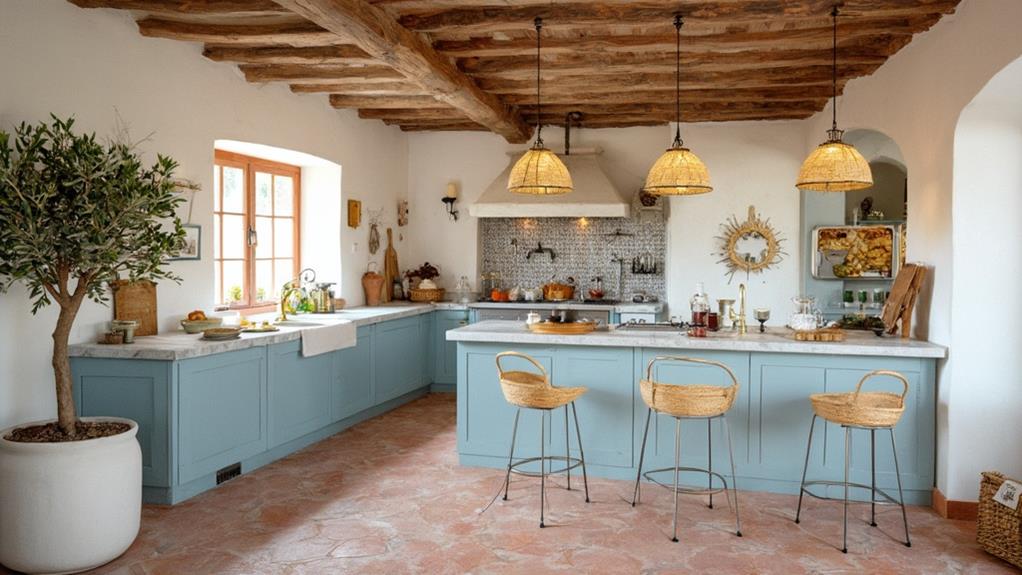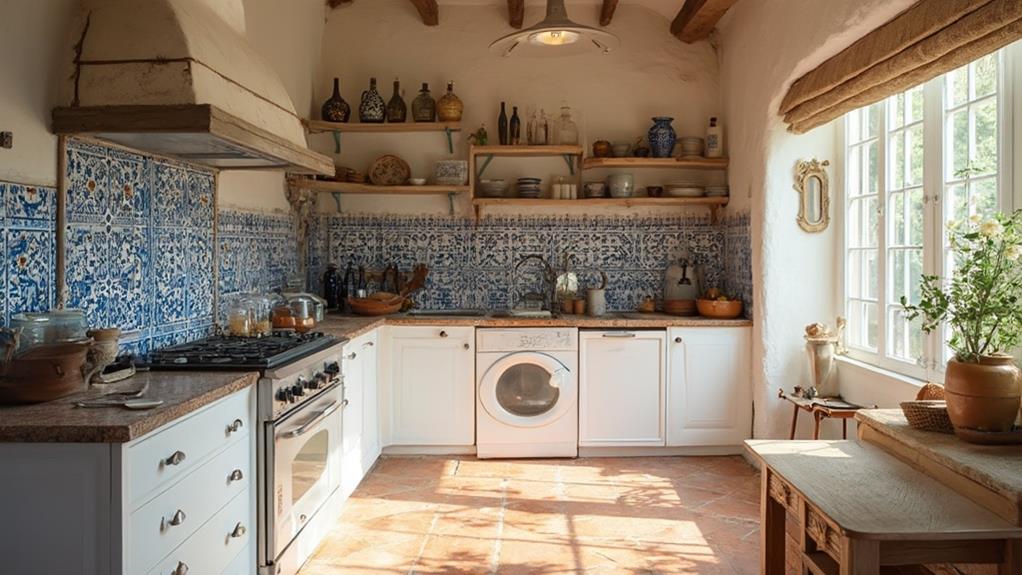To create a Mediterranean-inspired kitchen oasis, start with a warm, earthy color palette featuring terracotta, ochre, and deep blues. Incorporate natural materials like stone flooring, honed marble countertops, and wooden beams. Add vibrant ceramic tiles for backsplashes or accent walls. Choose wrought iron or copper lighting fixtures for a rustic touch. Install open shelving and mix in closed cabinets for a balanced look. Use hand-painted tiles and colorful ceramics as decorative elements. Don't forget to include plenty of natural light and connect your kitchen to outdoor spaces. By focusing on these key elements, you'll be well on your way to achieving a stunning Mediterranean ambiance in your kitchen.
Color Palette and Textures

When designing a Mediterranean-inspired kitchen, the color palette and textures you choose set the foundation for the entire space. Opt for warm, earthy tones like terracotta, ochre, and deep blues to evoke the sun-drenched landscapes of the Mediterranean. Incorporate rich, golden yellows and vibrant greens to add depth and visual interest.
For walls, consider using textured plaster or limewash paint to create a rustic, timeworn look. Install colorful ceramic tiles as a backsplash or on the floor to introduce intricate patterns and a touch of artistry. Natural materials like stone and wood are essential; use them for countertops, open shelving, or exposed ceiling beams.
Don't shy away from mixing textures. Pair smooth surfaces with rough ones, like glossy marble countertops with a rough-hewn wooden island. Introduce woven elements through baskets or chair seats to add warmth and authenticity. For cabinetry, distressed or weathered finishes work well, complementing the overall rustic aesthetic.
Natural Materials and Finishes
How can you authentically capture the essence of a Mediterranean kitchen without embracing natural materials and finishes? These elements are crucial in creating the warm, rustic charm that defines this style. Start with your flooring, opting for terracotta tiles or natural stone like limestone or travertine. These materials not only look beautiful but also feel cool underfoot, perfect for hot Mediterranean climates.
For countertops, consider using honed marble or granite in earthy tones. Wood plays a significant role too; incorporate it through ceiling beams, open shelving, or a farmhouse-style dining table. Choose distressed or reclaimed wood for an aged, lived-in feel.
When it comes to finishes, aim for a mix of textures. Use rough-hewn stone for a feature wall or backsplash. Add wrought iron accents through light fixtures, pot racks, or cabinet hardware. Don't forget about copper; its warm glow can be introduced through cookware or a statement range hood.
Lastly, embrace imperfection. Look for handmade ceramic tiles with slight variations in color and texture for your backsplash or as decorative accents. These natural materials and finishes will create an authentic, inviting Mediterranean atmosphere in your kitchen.
Lighting and Decorative Elements

With the foundation of natural materials set, it's time to illuminate your Mediterranean kitchen oasis. Start by incorporating warm, ambient lighting that mimics the sun-drenched coasts of the region. Install pendant lights with wrought iron or copper finishes above your kitchen island or dining area. Consider adding under-cabinet lighting to highlight your beautiful tile work and create a soft glow.
For decorative elements, embrace the vibrant colors and patterns of the Mediterranean. Hang colorful ceramic plates or tiles on the walls as art pieces. Display terra cotta pots filled with herbs like basil, rosemary, and thyme on your windowsill or countertops. Introduce woven baskets for storage and texture.
Don't forget to add a touch of greenery with potted olive trees or citrus plants. Hang copper or brass pots and pans from a ceiling rack for both functionality and visual interest. Finally, incorporate textiles like striped dish towels or a patterned area rug to add warmth and comfort to your space. These lighting and decorative elements will bring your Mediterranean kitchen to life, creating a welcoming and inviting atmosphere for cooking and entertaining.
Cabinetry and Storage Solutions
Cabinetry plays a crucial role in achieving the Mediterranean look and feel in your kitchen. Opt for natural wood finishes like oak, pine, or cherry to create a warm, rustic ambiance. You'll want to choose cabinets with simple, clean lines and avoid ornate designs. Consider distressed or weathered finishes to add character and authenticity to your space.
Open shelving is a popular choice in Mediterranean kitchens, allowing you to display colorful dishes, pottery, and herbs. Mix open shelves with closed cabinets for a balanced look and practical storage. For lower cabinets, consider drawers instead of doors for easier access to pots and pans.
Incorporate woven baskets and ceramic jars for additional storage and a touch of traditional charm. Use pull-out pantry shelves to maximize space and keep your ingredients organized. Don't forget about vertical storage solutions, such as hanging pot racks or wall-mounted knife strips, to free up counter space and add visual interest.
For a truly authentic touch, integrate a built-in wine rack or a dedicated area for storing and displaying olive oils and vinegars. These elements not only enhance the Mediterranean aesthetic but also improve functionality in your kitchen oasis.
Tile Designs and Patterns

In keeping with Mediterranean design, tile plays a starring role in creating an authentic kitchen oasis. You'll want to incorporate vibrant, patterned tiles that reflect the region's rich artistic heritage. Consider using hand-painted ceramic tiles for a backsplash or focal point, featuring intricate geometric designs or colorful floral motifs.
For flooring, opt for terracotta tiles in warm, earthy tones. Their natural, rustic appearance adds depth and character to your kitchen. Alternatively, you can choose encaustic cement tiles with bold patterns to make a striking statement underfoot.
Don't limit yourself to just floors and walls. Incorporate decorative tiles on countertops, around window frames, or even on the kitchen island. Mix and match different patterns and colors for an eclectic, yet cohesive look.
When selecting tiles, focus on Mediterranean-inspired hues like deep blues, sunny yellows, and rich greens. Remember to balance bold patterns with solid colors to avoid visual overload. For a more subtle approach, use patterned tiles sparingly as accents among larger, plain tiles. This strategy allows you to create eye-catching focal points without overwhelming the space.
Functional Layout and Flow
While aesthetics play a significant role in creating a Mediterranean-inspired kitchen, the space's functionality remains paramount. To achieve an efficient layout, consider the classic work triangle concept, connecting your sink, stove, and refrigerator. This arrangement minimizes unnecessary steps and streamlines your cooking process.
Incorporate ample counter space for food preparation and serving, especially near the cooking area. You'll want to include a large island or peninsula, which not only provides additional workspace but also serves as a gathering spot for family and friends. Don't forget to integrate plenty of storage solutions, such as open shelving for displaying colorful dishes and pantry staples.
Ensure proper lighting throughout the kitchen, combining task lighting for work areas with ambient lighting to create a warm atmosphere. Consider installing large windows or French doors to bring in natural light and connect your kitchen to outdoor spaces, a hallmark of Mediterranean living.
Lastly, create designated zones for different activities like cooking, cleaning, and dining. This approach will help maintain an organized and efficient flow, allowing you to move seamlessly through your kitchen while enjoying its Mediterranean-inspired charm.
Conclusion
You've created your Mediterranean dream kitchen, filled with warm hues, rustic textures, and charming details. It's a perfect oasis, transporting you to sun-drenched coastal villages. Yet, ironically, as you stand in this carefully crafted space, you might find yourself longing for the authentic, imperfect charm of real Mediterranean kitchens. Remember, true Mediterranean style isn't about perfection, but about embracing life's beautiful imperfections and creating a space where memories are made and stories unfold.

